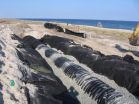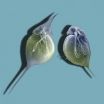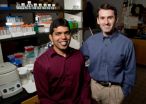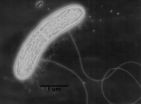(Press-News.org) A study published today in the journal Nature Genetics explores a new mechanism that may contribute to the development of several tumours, including Chronic Lymphocytic Leukaemia, a type of cancer that affects more than a thousand new patients in Spain each year.
This work, led by researchers Carlos López-Otín, from the University Institute of Oncology at the University of Oviedo; Elías Campo, from the Hospital Clínic/University of Barcelona; and María Blasco, the Director of the Spanish National Cancer Research Centre (CNIO), represents a significant milestone for the Spanish Consortium in the study of the Chronic Lymphocytic Leukaemia Genome.
"Chronic Lymphocytic Leukaemia is the most frequent leukaemia in Western countries," says López-Otín, adding that, "Once the most frequent genetic and epigenetic changes in its development have been decoded, it's necessary to discover the biochemical mechanisms altered by those changes, in order to be able to improve the diagnosis and treatment of this disease."
Thus, continuing the work from previous studies led by Campo and López-Otín published in Nature and Nature Genetics over the past two years, the researchers concentrated on the mutations affecting POT1, one of the genes involved in the protection of the ends of chromosomes, the telomeres.
This is the first time that a gene with this function has appeared mutated in a human cancer. Blasco says: "We have been studying telomere biology for a long time, given that alterations in telomere maintenance are associated with cancer and ageing. Although the mechanisms used by tumour cells to alter their telomeres have been identified, POT1 mutations reveal yet another, previously unknown route."
Each chromosome has, at its extremes, in its telomeres, a protective hood made up of proteins, and POT1 is the staple that fixes it in place, joining it to the telomeric DNA. All of the mutations discovered in POT1 prevent this gene from fulfilling its function. The DNA at the end of the chromosome is therefore left without its protective cover. The study of the biochemical pathway that leads from these abnormalities to the uncontrolled growth of B lymphocytes can provide important clues for the understanding of chronic lymphocytic leukaemia and cancer in general.
ONE OF THE MOST FREQUENTLY MUTATED GENES IN LEUKAEMIA
Furthermore, after analysing the genome of 341 chronic lymphocytic leukaemia patients —comparing for each case the genes from normal healthy cells with those of tumour cells—, researchers have discovered that POT1 is one of the most frequently mutated genes in this illness.
Prior results from the Spanish Consortium for the study of the Chronic Lymphocytic Leukaemia Genome had already shown that more than a thousand mutations are involved in this disease, and that each patient has a unique combination of hundreds of them. One of the most unexpected findings of the Consortium's studies is the wide genetic and molecular diversity of the disease. The different mutated genes identify relatively small subgroups of patients with diverse disease characteristics. In fact, the most frequently-repeated mutations are only present in 15% of patients. Despite that, identifying them represents a great advance, because it is a step towards the goal of personalised therapies, adapted to the genetic profile of each individual tumour.
In the study published today, the researchers have found that 3.5% of patients with chronic lymphocytic leukaemia show POT1 mutations, but this figure rises to 9% in a subgroup of patients suffering from an especially aggressive form of the disease. In this way, the study identifies POT1 as one of the most important genes for this disease.
As Campo concludes, "Patients with POT1 mutations belong to the group that has the worst prognosis. Therapeutic intervention affecting this pathway could, therefore, help treat a group of patients whose clinical outcome is currently very poor."
###
The Spanish Consortium for the Study of the Chronic Lymphocytic Leukaemia Genome is financed by the Ministry of Economy and Competitiveness via the National Institute of Health Carlos III, and is within the framework of the International Cancer Genome Consortium (ICGC). Three years ago, the journal Nature highlighted the potential relevance of the anticipated research results from the ICGC in the development of new diagnostic and therapeutic methods to fight cancer, given that the consortium plans for the large-scale coordination of the sequencing and analysis of 500 tumour genomes from each of the 50 most frequent cancers. Since then, Nature and Nature Genetics have published several articles on the most recent advances from the Spanish members of the ICGC team, which are based on the analysis of genomic and epigenomic alterations in more than one hundred CLL patients. The new study published by Nature Genetics delves deeper into one of the most surprising discoveries to come out of those first studies and contributes to emphasise the relevance of telomere dynamics. Telomeres are key structures for better understanding complex processes such as cancer and ageing.
The Spanish contribution to this international consortium integrates the work of more than a dozen institutions, amongst which we find the Hospital Clínic in Barcelona, the University of Barcelona, the University institute of Oncology at the University of Oviedo, the Centre for Genomic Regulation in Barcelona, the Catalan Oncology Institute, Salamanca's Cancer Research Centre, the National DNA Bank, the Spanish National Cancer Research Centre (CNIO), the University of Deusto, the University of Santiago de Compostela, the Barcelona Supercomputing Center, the National Centre for Genomic Analysis and the August Pi I Sunyer Biomedical Research Institute.
Spanish researchers link cancer to failures in chromosome protection for the first time
This is the first time that an essential gene for the protection of telomeres, the ends of chromosomes, has appeared mutated in human cancer
2013-03-19
ELSE PRESS RELEASES FROM THIS DATE:
Researchers devise hidden dune filters to treat coastal stormwater runoff
2013-03-19
When it rains, untreated stormwater can sweep pollutants into coastal waters, potentially endangering public health. Now researchers from North Carolina State University have developed low-cost filtration systems that are concealed beneath sand dunes and filter out most of the bacteria that can lead to beach closures.
"It was not economically feasible to use a tract of beachfront property to treat stormwater. Instead, we were able to devise a system that could be installed in an area that was not developable – underneath the dunes," says Dr. Michael Burchell, an assistant ...
It's a sure thing: Knowledge of the game is not an advantage in sports gambling
2013-03-19
Psychologists have traditionally characterized compulsive gambling as an "impulse control disorder," and treated it by addressing the patient's obsessive tendencies. But according to Prof. Pinhas Dannon of Tel Aviv University's Sackler Faculty of Medicine and the Beer Yaakov Mental Health Center, not all pathological gamblers fit the same profile.
Though gambling is typically associated with casino games, strategic sports betting is rapidly gaining in popularity — and that's a whole other ball game, Prof. Dannon explains. "Sports gamblers seem to believes themselves the ...
Can a tropical water flea invade European lakes?
2013-03-19
Daphnia is a genus of small, planktonic crustaceans, commonly called 'water fleas' because of their jumpy swimming style and their size (between 0.2 and 5 mm). They live in various aquatic environments, ranging from acidic swamps to freshwater lakes, ponds, streams and rivers. Species of the genus Daphnia play a key role in freshwater food webs: they consume algae and are themselves an important food item for small fish.
Daphnia lumholtzi is a small subtropical and tropical representative, known as an invader in North America. It has never been found in Europe in the ...
Caterpillar-walk exhumation, the downfall of the Moche, and trilobites in camouflage
2013-03-19
Boulder, Colo., USA – New Geology articles posted online ahead of print cover everything from cratering on Mars to leopard-like camouflage in trilobites. Locations studied include the Ries Impact Crater; Hydrate Ridge, Oregon; Stromboli volcano; northern Peru; the Bushveld Complex, South Africa; western and central New York state; the Sahara Desert; and the French Alps. Brief highlights follow:
1. Analogous cratering at the Ries Impact Crater, Germany, and on Mars;
2. A presentation of the first secure, high-resolution land-sea PSV-based sediment-core synchronization;
3. ...
Wireless, implanted sensor broadens range of brain research
2013-03-19
A compact, self-contained sensor recorded and transmitted brain activity data wirelessly for more than a year in early stage animal tests, according to a study funded by the National Institutes of Health. In addition to allowing for more natural studies of brain activity in moving subjects, this implantable device represents a potential major step toward cord-free control of advanced prosthetics that move with the power of thought. The report is in the April 2013 issue of the Journal of Neural Engineering.
"For people who have sustained paralysis or limb amputation, rehabilitation ...
DNA catalysts do the work of protein enzymes
2013-03-19
CHAMPAIGN, Ill. — Illinois chemists have used DNA to do a protein's job, creating opportunities for DNA to find work in more areas of biology, chemistry and medicine than ever before.
Led by Scott Silverman, a professor of chemistry at the University of Illinois at Urbana-Champaign, the researchers published their findings in the journal Proceedings of the National Academy of Sciences.
Ideally, researchers would like to be able to design and build new catalysts from scratch that can do exactly what they want. Many enzymes make small modifications to the building blocks ...
UMass Amherst researchers reveal mechanism of novel biological electron transfer
2013-03-19
AMHERST, Mass. – When researchers at the University of Massachusetts Amherst led by microbiologist Derek Lovley discovered that the bacterium Geobacter sulfurreducens conducts electricity very effectively along metallic-like "microbial nanowires," they found physicists quite comfortable with the idea of such a novel biological electron transfer mechanism, but not biologists.
"For biologists, Geobacter's behavior represents a paradigm shift. It goes against all that we are taught about biological electron transfer, which usually involves electrons hopping from one molecule ...
Sex between monogamous heterosexuals rarely source of hepatitis C infection
2013-03-19
Individuals infected by the hepatitis C virus (HCV) have nothing to fear from sex in a monogamous, heterosexual relationship. Transmission of HCV from an infected partner during sex is rare according to new research published in the March issue of Hepatology, a journal published by Wiley on behalf of the American Association for the Study of Liver Diseases (AASLD).
Experts estimate that HCV affects up to 4 million Americans, most of whom are sexually active. Medical evidence shows HCV is primarily transmitted by exposure to infectious blood, typically through intravenous ...
Greenhouse gas policies ignoring gap in household incomes: University of Alberta study
2013-03-19
Government policies aimed at reducing greenhouse gas emissions from consumers need to be fairer for household income levels, says a University of Alberta researcher.
A U of A study published recently online in the journal Environment and Behaviour looks at the different sources of greenhouse gas emissions from consumers, based on their income levels. The wealthiest households in Alberta emit the most greenhouse gases, but too often, income disparity hasn't been factored in to current polices—such as the carbon flat tax that is levied to British Columbia residents.
Such ...
Kill Bill character inspires the name of a new parasitoid wasp species
2013-03-19
Parasitoid wasps of the family Braconidae are known for their deadly reproductive habits. Most of the representatives of this group have their eggs developing in other insects and their larvae, eventually killing the respective host, or in some cases immobilizing it or causing its sterility. Three new species of the parasitoid wasp genus Cystomastacoides, recently described in the Journal of Hymenoptera Research, reflect this fatal behavior.
Two of the new species were discovered in Papua New Guinea, while the third one comes from Thailand. The Thai species, Cystomastacoides ...
LAST 30 PRESS RELEASES:
Advances in understanding the evolution of stomach loss in agastric fishes
Social media affects people’s views on mental illness
Aerogel-based PCMs improve thermal management, reduce microwave emissions in electronic devices
Undernourished household members at increased risk for developing TB after exposure
A non-equivalent co-doped strategy to effectively improve the electrical properties of BIT-based high-temperature piezoelectric ceramics
RAMP1 protects hepatocytes against ischemia-reperfusion injury by inhibiting the ERK/YAP pathway
Molecular mechanism of chemical diversity of thermophilic fungus and its ecological and biological functions
Engaging pharmacists to improve atrial fibrillation care
Exploring brain synchronization patterns during social interactions
Unveiling the molecular functions of lipid droplet proteins in Arabidopsis thaliana leaves
Perfecting the view on a crystal’s imperfection
Fossil frogs share their skincare secrets
Existing drugs studied in patients with rare immune diseases
Loma Linda University study reveals alarming rates of pediatric injuries from mechanical bull riding
Excessive pregnancy weight gain and substantial postpartum weight retention common in military health care beneficiaries
Odor-causing bacteria in armpits targeted using bacteriophage-derived lysin
Women’s heart disease is underdiagnosed, but new machine learning models can help solve this problem
Extracting high-purity gold from electrical and electronic waste
Tropical fish are invading Australian ocean water
No bull: How creating less-gassy cows could help fight climate change
ECU researchers call for enhanced research into common post-stroke condition
SharpeRatio@k: novel metric for evaluation of risk-return tradeoff in off-policy evaluation
$1.8M NIH grant will help researchers follow a virus on its path to the nucleus
Follow-up 50 years on finds landmark steroid study remains safe
Active military service may heighten women’s risk of having low birthweight babies
Significant global variation in national COVID-19 treatment guidelines
Cost increasingly important motive for quitting smoking for 1 in 4 adults in England
Is there an association between HPV vaccination and anti-NMDA receptor encephalitis?
Blood-based multi-omics guided detection of a precancerous pancreatic tumor
Eye-opener: Pupils enlarge when people focus on tasks
[Press-News.org] Spanish researchers link cancer to failures in chromosome protection for the first timeThis is the first time that an essential gene for the protection of telomeres, the ends of chromosomes, has appeared mutated in human cancer





